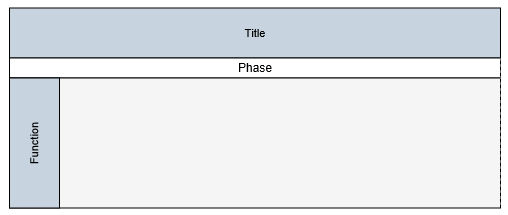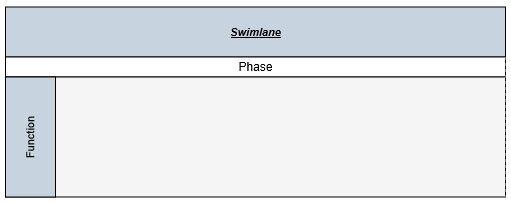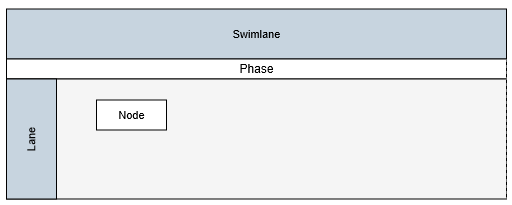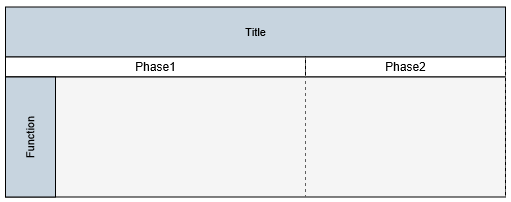Swim lane in Angular Diagram
22 Jul 202224 minutes to read
Swim-lane Diagrams are typically used to visualize the relationship between a business process and the department responsible for it by focusing on the logical relationships between activities. Swimlanes may be arranged either horizontally or vertically.
Initialize Diagram
Add a placeholder div element that can be used to initialize the diagram widget as shown below.
<div>
<ej-diagram id="diagramCore" width="100%" height="100%">
</ej-diagram>
</div>import {Component} from '@angular/core';
@Component({
selector: 'ej-app',
templateUrl: 'app/components/diagram/swimlane.component.html',
})
export class SwimlaneComponent {
constructor() {}}Create a swimlane
To create a swimlane, you need to define an object with isSwimlane property that helps identify the object as a swimlane. By default, the swimlanes are arranged vertically. You can change that with the orientation property of swimlane.
The following code example illustrates how to define a swimlane object.
export class SwimlaneComponent {
nodes: Array<any>;
constructor() {
this.nodes = [{
type: "swimlane",
name: "swimlaneNode",
//Changes the orientation
orientation: "horizontal",
//Sets the position and size
offsetX: 400,
offsetY: 200,
height: 100,
width: 700
}]
}
}Add swimlane into diagram
Adding a swimlane to the Diagram is same as adding a node. You can add either through the nodes collection or through the client side method add. You can also drag and drop a swimlane from symbol palette.
For more information about adding a node/swimlane to the Diagram, refer to Add Nodes.
The following code example illustrates how to add a swimlane to the Diagram through nodes collection.
<div>
<ej-diagram id="diagramCore" width="100%" height="100%" [nodes]="nodes">
</ej-diagram>
</div>
Headers
Swimlane allows to define a header to textually describe it. The header property of swimlane allows you to define its textual description(text) and to customize its appearance. The following code example illustrates how to define swimlane header.
export class SwimlaneComponent {
nodes: Array<any>;
constructor() {
this.nodes = [{
type: "swimlane",
name: "swimlane",
//Defines the header and format its text
header: {
'text': 'Swimlane',
'height': 50,
'fillColor': '#C7D4DF',
'fontSize': 11,
'fontFamily': "Arial",
'bold': true,
'italic': true,
'textDecoration': "underline" },
orientation: "horizontal",
offsetX: 400,
offsetY: 200,
height: 100,
width: 700
}]
}
}
Disable headers
You can hide the swimlane headers. The following code example illustrates how to hide headers.
var header = {
text: "Swimlane",
//Sets "0" to hide header
height: 0
};Lane
Lane is a functional unit or a responsible department of a business process that helps to map a process within the functional unit or in between other functional units.
You can add any number of lanes to a swimlane and the lanes are automatically stacked inside a swimlane based in the order they are added.
Create an empty lane
To create an empty lane, you need to define an object with isLane property that helps identify the object as a lane. The following example illustrates how to define a swimlane with a lane.
export class SwimlaneComponent {
nodes: Array<any>;
constructor() {
this.nodes = [
{
'type': 'swimlane', 'name': 'swimlane',
//Defines an empty lane
'lanes': [
{
'name': 'lane1',
'fillColor': '#f5f5f5',
'height': 120,
//Sets the object as Lane
'isLane': "true"
}],
'orientation': "horizontal",
'offsetX': 400,
'offsetY': 200,
'height': 100,
'width': 700
}
]
}
}Create a lane with header
The header property of the lane allows you to textually describe the lane(text) and to customize the appearance of the description. The following code example illustrates how to define a lane header.
You can limit the size of a lane with its minWidth, minHeight, maxWidth, and maxHeight properties.
export class SwimlaneComponent {
nodes: Array<any>;
constructor() {
this.nodes = [
{
'type': 'swimlane',
'name': 'swimlane',
//Defines the lane
'lanes': [
{
'name': 'lane1',
'fillColor': '#f5f5f5',
'height': 120,
//Sets the object as Lane
'isLane': "true",
//Defines the lane header
'header':{
text: "swimlane label",
fillColor: "#C7D4DF",
fontColor: "black",
fontSize: 15,
fontFamily: "Arial",
bold: false,
italic: false,
textDecoration: "none"
},
//Specifies the minimum and maximum size of the lane
'minWidth': 500,
'maxWidth': 700,
'minHeight': 120,
'maxHeight': 200,
}],
'orientation': "horizontal",
'offsetX': 400,
'offsetY': 200,
'height': 100,
'width': 700
}
]
}
}Add nodes to a lane
To add nodes to a lane, You need to add them to the children collection of lane. The following code example illustrates how to add nodes to a lane.
export class SwimlaneComponent {
nodes: Array<any>;
constructor() {
this.nodes = [
{
'type': 'swimlane',
'name': 'swimlane',
//Defines the lane
'lanes': [
{
'name': 'lane1',
'fillColor': '#f5f5f5',
'height': 120,
//Sets the object as Lane
'isLane': "true",
//Defines children of lane
children:{
name: "node",
width: 70,
height: 30,
labels: [{
text: "Node",
}],
// Specifies the margin values of the child
marginLeft: 70,
marginTop: 1
}
//Defines the lane header
'header':{
text: "swimlane label",
fillColor: "#C7D4DF",
fontColor: "black",
fontSize: 15,
fontFamily: "Arial",
bold: false,
italic: false,
textDecoration: "none"
},
//Specifies the minimum and maximum size of the lane
'minWidth': 500,
'maxWidth': 700,
'minHeight': 120,
'maxHeight': 200,
}],
'orientation': "horizontal",
'offsetX': 400,
'offsetY': 200,
'height': 100,
'width': 700
}
]
}
}
Phase
Phases are the sub-processes that are used to break the swimlane into multiple smaller regions.
Add phase
To define a phase, you have to set the length of the region to the offset property of phase. Every region can be textually described with the label property of phase.
The following code example illustrates how to add a phase on initializing swimlane.
export class SwimlaneComponent {
nodes: Array<any>;
constructor() {
this.nodes = [
{
'type': 'swimlane', 'name': 'swimlane',
'header': {'text': 'ONLINE PURCHASE STATUS', 'height': 50, 'fillColor': '#C7D4DF', 'fontSize': 11 },
'fillColor': '#f5f5f5', 'orientation': 'horizontal', 'offsetX': 350, 'offsetY': 290, 'height': 100, 'width': 650,
//Creates a phase
'phases': [
{ 'name': 'phase1',
//Length of the first region
'offset': 300,
//Initializes labels for phases
'label': {
'text': "Phase1"
},
//Specifies the appearance of separator
'lineWidth': 1, 'lineDashArray': '3,3', 'lineColor': '#606060',
},
{
'name': 'phase2',
'label': { 'text': 'Phase' }
}
],
'phaseSize': 20,
//Adds lanes and header as mentioned in header and lane section
}
];
}
}
Limitations
- You cannot add connectors as the children of lanes.